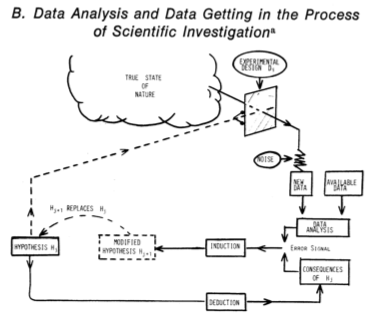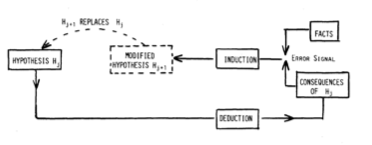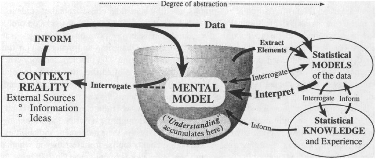| << Chapter < Page | Chapter >> Page > |



While different, the three diagrams suggest some salient aspects of the data analysis process:
Data analysis shares these features with a process that has been well studied by cognitive scientists: sense making.
SENSE-MAKING
Sensemaking is an area of cognitive science that examines how the human brain creates understanding from its surroundings. Itbegan in the 1970’s as an extension of communication theory, but was then adopted by experimental and theoretical psychologists. According to sensemakingresearch, the human brain continuously scans its environment for data and builds this data into a mental model that explains its surroundings. A couple ofsensemaking models exist to explain how this occurs (e.g, the cost structure model, the data-frame model), but each has the same basic components.

The brain begins with a tentative theory, which is also called a model, a schema, or a frame. This theory suggests to the brainwhat is and what is not relevant data. The brain then constructs this data from the external stimuli it receives through the sense organs. An important facet ofsensemaking is that the mind does not automatically accept all present stimuli as data. It instead decides which stimuli would be relevant, searches for them,and then synthesizes them into a piece of data.
The brain compares its currently held theory to the data it has collected. It confirms the theory if the theory accurately fitsthe data. Otherwise, it will modify the theory to better fit the data or completely reject the theory in favor of a new one. The process occurscontinuously; the brain constantly refines existing theories against new data.
A theory provides understanding by describing the relationships between data. These relationships assign meaning to the datapoints and also allow predictions of unobserved data from observed data. A theory also allows the mind to encode data more efficiently than just storingthe raw bits. In this way, sensemaking resembles parametric modeling. The brain retains the theory instead of the raw data, but retains the informationcontained in the data in the parameters of the theory. Different types of theories can describe different types of relationships among data. Mental mapsdescribe spatial relationships, stories describe temporal and causal relationships, scripts describe roles, plans describe an intended sequence ofevents, etc. (Klein et al. 2003)
WHY SENSE-MAKING?
Sensemaking shares all of the salient features of data analysis noted above, but there are other reasons to suspect that cognitivescience may offer a theoretical foundation for data analysis.
Almost all data analysis is conducted by humans in order to improve their understanding of the world. Hence, data analysisextends the sensemaking process. Moreover, data analysts may use their internal reasoning processes as a model for their data analysis.

Notification Switch
Would you like to follow the 'The art of the pfug' conversation and receive update notifications?